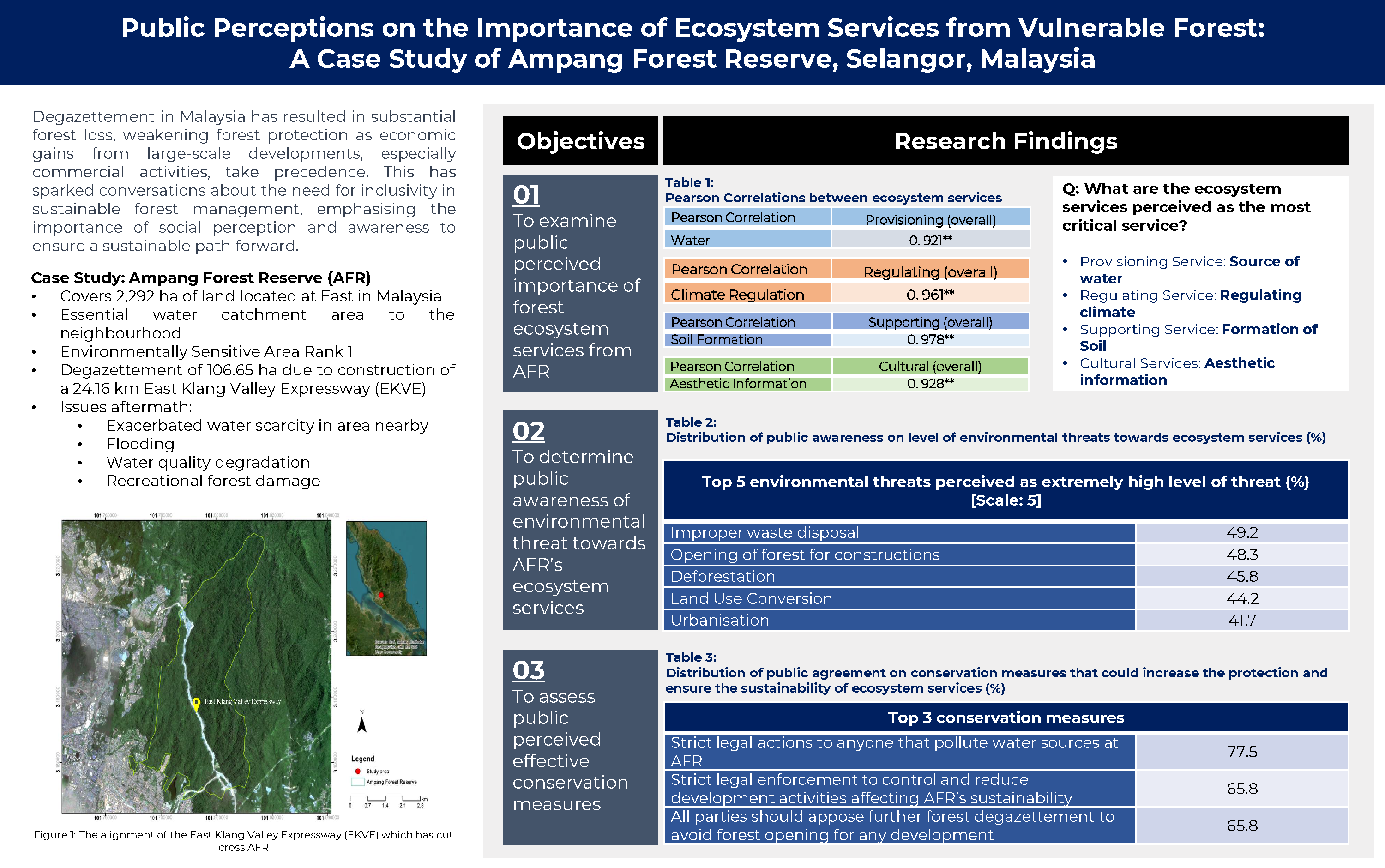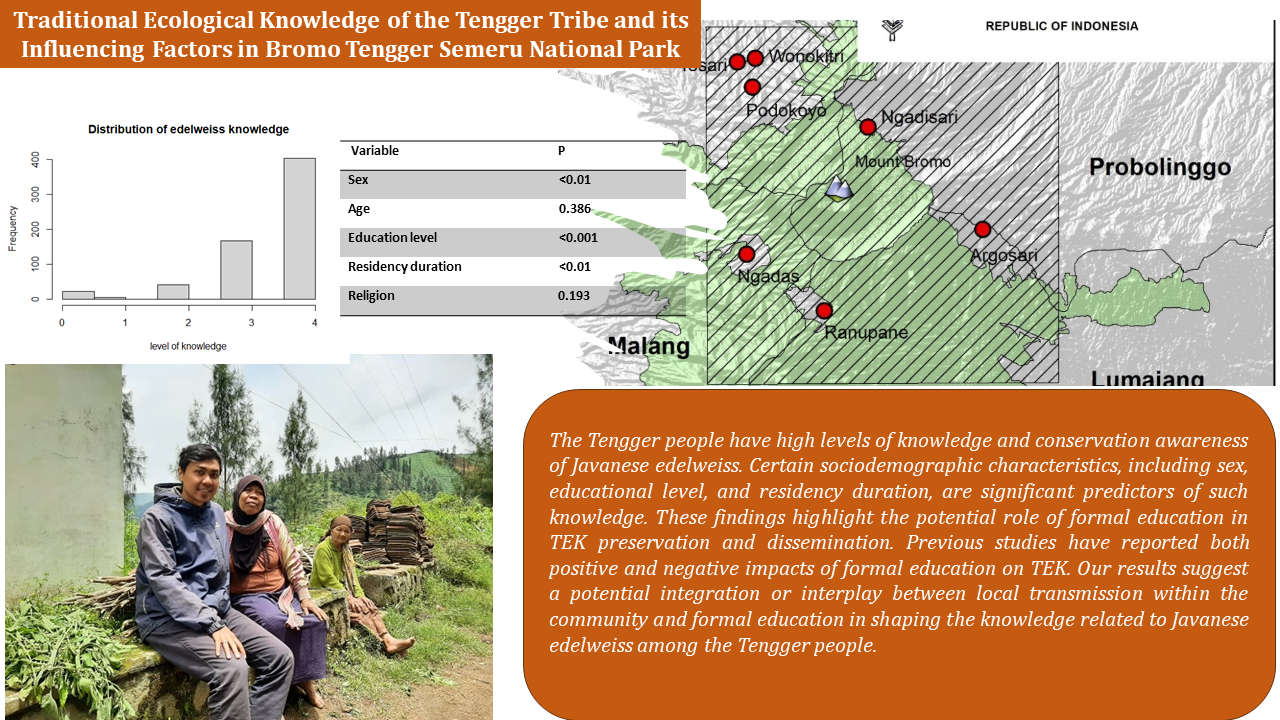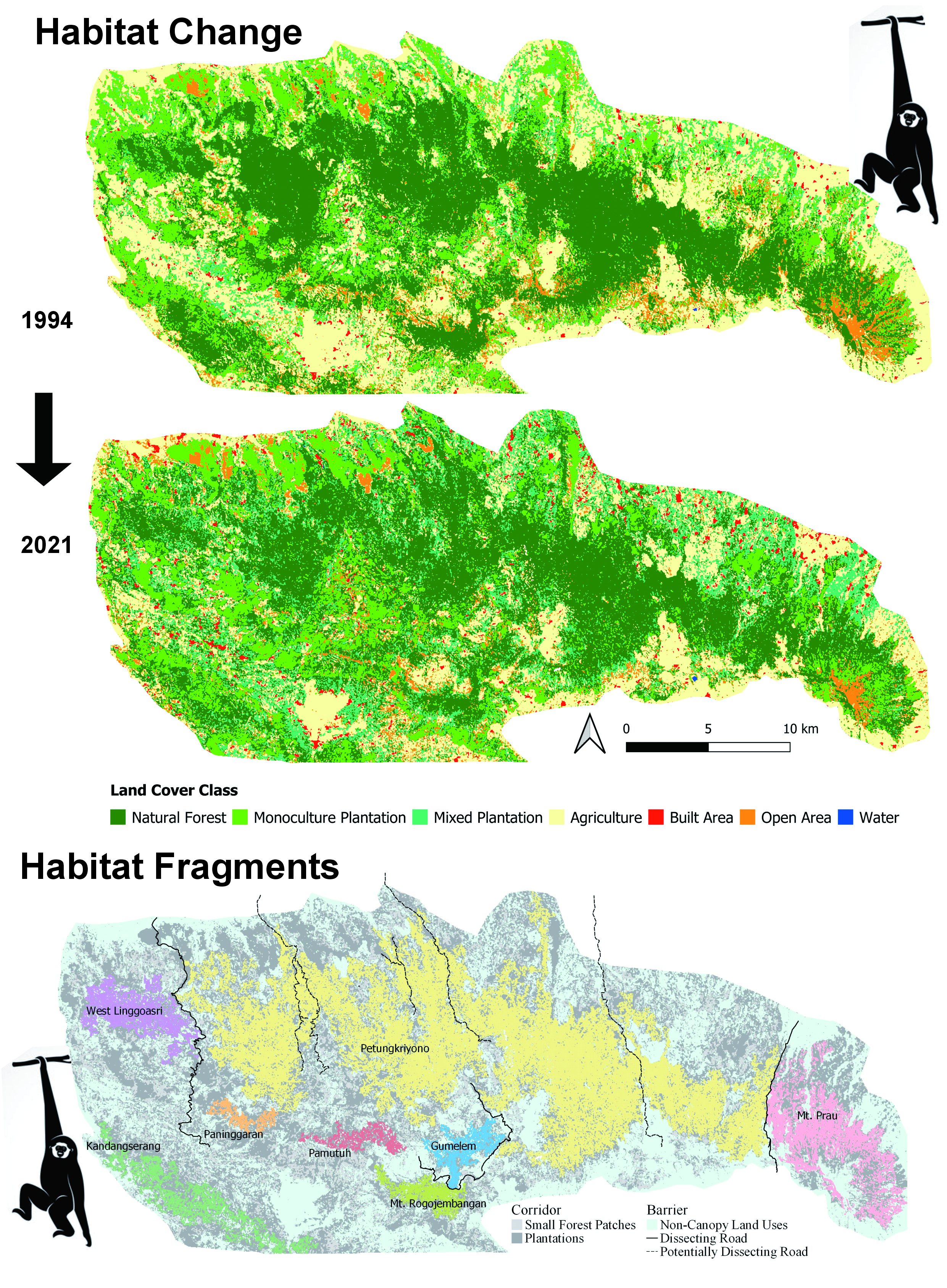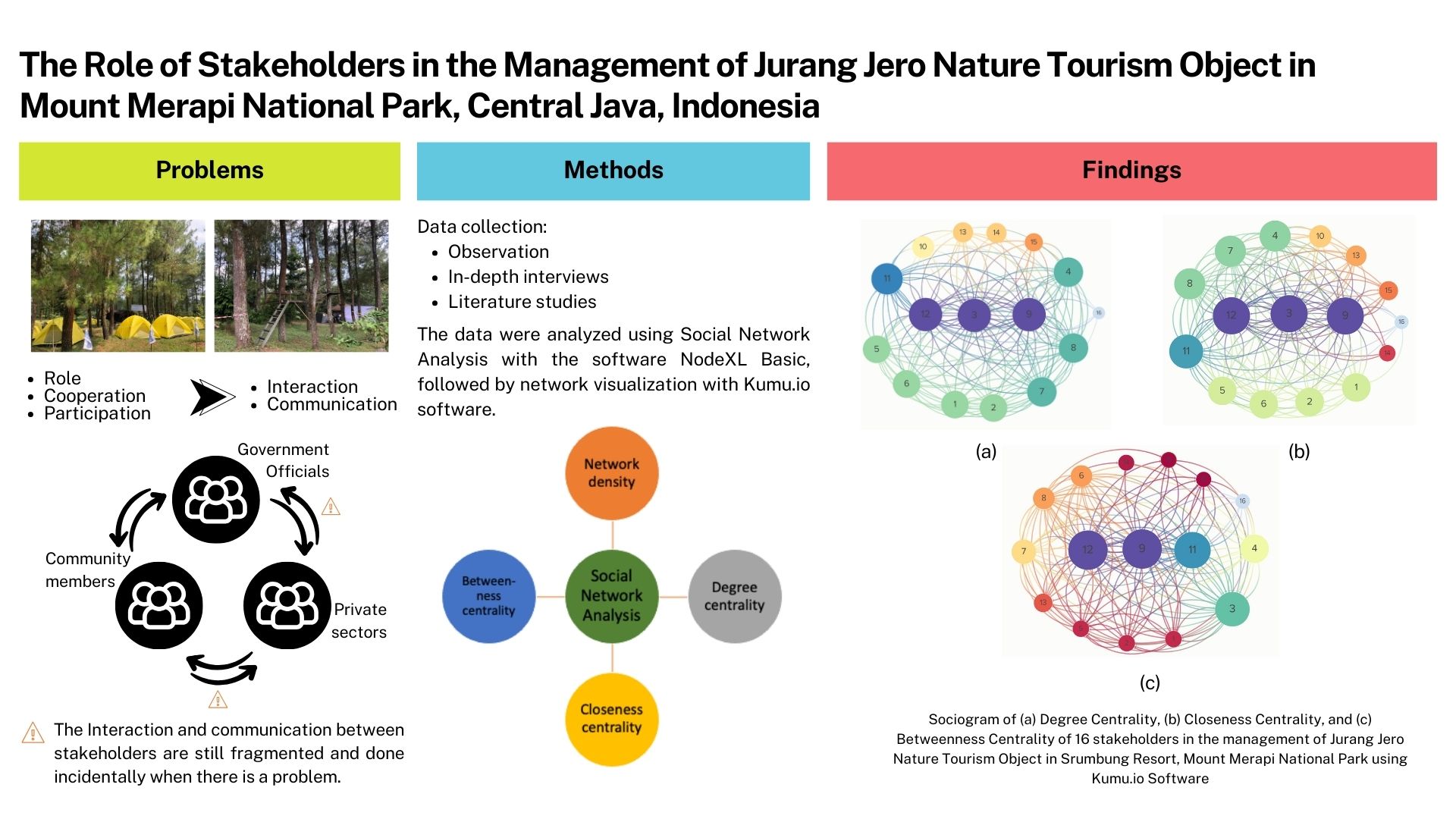Abstract
Social capital has an important role in mangrove management on conservation areas. Utilization of mangrove forest with silvofishery system can be an alternative developed for the community around the conservation areas. The purpose of this research is to know the strength of social capital in supporting the utilization of mangrove for silvofishery. This research adopted Social Capital Assessment Tool method and data analysis with Partial Least Square-Structural Equation Modeling. The results of the study found that there were several elements of social capital in five study villages that have not supported silvofishery in Kutai National Park (KNP), East Kalimantan, Indonesia. The overall analysis of the respondents showed that there were five elements of social capital have significant effect on silvofishery. The other two elements were insignificant and should be of particular concern to be improved, i.e. social networks and social norms. Indicators to be aware of were the increased knowledge of communities on park-related regulations, increased involvement of individuals in the community, and the strengthening of public figures who can be role models for the community. Mangrove forest of KNP should be kept as conservation area, but it should still pay attention to the socio-economic conditions of the surrounding community. The strength of social capital is expected to realize conservation-based economic development.
References
Asmin F, Darusman D, Ichwandi I, Suharjito D. 2017. Social capital of parak and rimbo management in West Sumatera. Jurnal Manajemen Hutan Tropika 23(3):140–149. https://doi.org/10.7226/jtfm.23.3.140
Anwar C, Gunawan H. 2006. Peranan Ekologis dan Sosial Ekonomis Hutan Mangrove dalam Mendukung Pembangunan Wilayah Pesisir. Makalah Utama pada Ekspose Hasil-hasil Penelitian: Konservasi dan Rehabilitasi Sumberdaya Hutan. Padang, 20 September 2006. 23−34.
Barnes-Mauthe M, Kirsten LLO, Luke MB, Bienvenue Z, Thomas AO, Pietervan B. 2015. Social capital as an ecosystem service: Evidence from a locally managed marine area. Ecosystem Services 16:283–293. https://doi.org//10.1016/j.ecoser.2014.10.009
Budiarsa AA, Rizal S. 2013. Pemetaan dan analisis tingkat kerusakan hutan mangrove di Taman Nasional Kutai berdasarkan data citra setelit Landsat ETM dan kerapatan vegetasi. Jurnal Ilmu Perikanan Tropis 19(1):54−61.
Brander LM, Wagtendonk AJ, Hussain SS, McVittie A, Verburg PH, de Groot RS, van der Ploeg S. 2012. Ecosystem service values for mangroves in Southeast Asia: A meta-analysis and value transfer application. Ecosystem Services 1:62−69. https://doi.org//10.1016/ j.ecoser.2012.06.003.
Bryce R, Irvine KN, Church A, Fish R, Ranger S, Kenter JO. 2016. Subjective well-being indicators for large-scale assessment of cultural ecosystem services. Ecosystem Services 21:258−269. https://doi.org//10.1016/ j.ecoser.2016.07.015.
Budihastuti, Anggoro RS, Saputra SW. 2012. The application of silvofishery on tilapia (Oreochromis niloticus) and milkfish (Chanos chanos) fattening within mangrove ecosystem og the Northern Coastal area of Semarang Citu. Journal of Coastal Development 16(1):89−93. https://doi.org/10.7454/mss.v21i4. 6475.
Burt RS. 1992. Excerpt from The Sosial Structure of Competition, in Structure Holes: The Social Structure of Competition. Cambridge, London.
Castellan CM. 2010. Quantitative and qualitative research: A View for Clarity. International Journal of Education 2(2):1−14.
Eddy S, Ridho MR, Iskandar I, Mulyana A. 2016. Community-based mangrove forests concervation for sustainable fisheries. Jurnal Silvikultur Tropika. 07(3):43−47.
Fukuyama F. 2000. Social capital and civil society. International Monetary Fund Working Paper, WP/00/74.
Grootaert C, van Bastelaer T. 2001. Understanding and measuring social capital: A synthesis of findings and recommendations from the social capital initiative. The World Bank. Social Development Department. Social Capital Working Paper Series, Washington, DC.
Grootaert C, Narayan D, Jones VN, Woolcock M. 2003 Measuring social capital: An integrated questionnaire. The world bank. social development family, environmentally and socially, sustainable development network, Washington, DC.
Hair JF, Hult GTM, Ringle CM, Sarstedt M. 2014. A Primer on Partial Least Squares Structural Equation Modeling (PLS-SEM). Los Angeles: Sage, Thousand Oak.
Hartoyo, Rochana E, Wirawan B. 2012. Penguatan Modal Sosial dalam Pelestarian Hutan Mangrove di Pulau Pahawang, Kecamatan Punduh Pidada, Kabupaten Pesawaran. Seminar Hasil-Hasil Penelitian dan Pengabdian Kepada Masyarakat-Dies Natalis FISIP Unila, Lampung.
Hastuti ED, Budihastuti R. 2017. Nutrient accumulation in the sediment of silvofishery ponds in Semarang. Makara Journal of Science 21(4):195−201. https://doi.org/10.7454/mss.v21i4.6475.
IUCN WCPA. 2017. PARKS: The international journal of protected areas and conservation. IUCN World Commissionon Protected Areas (WCPA). 23(1), Gland, Switzerland: IUCN.
Juita K, Nababan, Qurniati R, Kustanti A, 2016. Modal sosial pada pengelolaan dan pelestarian hutan mangrove di Kecamatan Labuhan Maringgai Kabupaten Lampung Timur. Jurnal Silva Lestari 4 (2):89−100.
Kithiia J. 2010. Old notion–new relevance: Setting the stage for the use of social capital resource in adapting East African coastal cities to climate change. International Journal of Urban Sustainable Development 1(1–2)17−32. https://doi.org/10.1080/1946313100 3607630.
Kunarso A, Tubagus AA, Syabana, Azwar F, Bastoni. 2015. Mangrove rehabilitation using silvofishery system in Telang Protection Forest, South Sumatra: Opportunities and challenges. Proceedings: The International Conference of Indonesia Forestry Researchers III. Bogor, 21 −22 October 2015.
Lee SY, Primavera JH, Guebas FD, McKee K, Bosire JO, Cannicci S, Diele K, Fromard F, Koedam N, Marchand C, Mendelssohn I, Mukherjee N, Record S. 2014. Ecological role and services of tropical mangrove ecosystems: a reassessment. Global Ecology and Biogeography. 23:726 −743. https://doi.org/10.1111/ geb.12155.
Luck DJ, Taylor WG, Robin. 1987. Marketing Research. Eaglewood: Prentice Hall.
Miguel A, Piqueras C, Trinogga J, Grande C, Minden V, Maier M, Kleyer M. 2017. Interactions between ecosystem properties and land use clarify spatial strategies to optimize trade-offs between agriculture and species conservation. International Journal of Biodiversity Science, Ecosystem Services & Management 13(2):53−66. https://doi.org/10.1080/ 21513732.2017.1289245.
Oktadiyani P, Muntasib EKSH, Sunkar A. 2013. Modal sosial masyarakat di kawasan penyangga Taman Nasional Kutai (TNK) dalam pengembangan ekowisata. Jurnal Media Konservasi 18 (1):1−9.
Poedjirahajoe E. 2011. Potensi ekosistem hutan mangrove untuk pengembangan silvofishery di Taman Nasional Alas Purwo. Prosiding: Forum Nasional Pemacuan Sumber Daya Ikan III, Yogyakarta: Fakultas Kehutanan Universitas Gadjah Mada.
Poedjirahajoe E. 2015. Klasifikasi habitat mangrove untuk pengembangan silvofishery kepiting soka (Scylla serrata) di Pantai Utara Kabupaten Rembang. Jurnal Ilmu Kehutanan 9(2):86−93.
Pretty J, Ward H. 2001. Social capital and the environment. World Development 29(2):209−227.
Purwiyanto AIS, Agustriani F. 2014. Effect of silvofishery on ponds nutrient levels. Jurnal Ilmu Kelautan 19(2):81−87.
Qurniati R, Wahyu H, Hari K, Firdasari, Makoto I. 2017. Social capital in mangrove management: A case study in Lampung Province, Indonesia. Journal of Forest and Environmental Science 33(1):8−21. https://doi.org/10.7747/JFES.2017.33.1.8.
Radnitz, Wheatley SJ, and Zürcher C. 2009. The origins of social capital: Evidence from a survey of post-soviet Central Asia. Comparative Political Studies. SAGE journal 42(6):707−732 https://doi.org/10.1177/ 0010414008329893.
Setiawan F, Triyanto. 2012. Studi kesesuaian lahan untuk pengembangan silvofishery kepiting bakau (Scylla serrata) di Kabupaten Berau, Kalimantan Timur. LIMNOTEK 19 (2):158–165
Sayektiningsih T, Gunawan W. 2012. Kondisi sosial ekonomi masyarakat di sekitar hutan mangrove Taman Nasional Kutai, Kalimantan Timur. Prosiding: Seminar hasil-hasil penelitian BPTKSDA Samboja, Balai Penelitian Teknologi Konservasi Sumber Daya Alam, Samboja.
Siswanto W. 2017. Pengelolaan kawasan konservasi di Indonesia. Kerjasama Forests and Climate Change Programmed dan Kementerian Lingkungan Hidup dan Kehutanan. Deutsche Gesellschaft für Internationale Zusammenarbeit (GIZ) GmbH. Bonn and Eschborn, Germany.
Sözbilir F. 2018. The interaction between social capital, creativity and efficiency in organizations. Thinking Skills and Creativity 27:92−100. https://doi.org/ 10.1016/j.tsc.2017.12.006.
Sulistyorini IS, Poedjirahajoe E, Edwin M, Imanuddin. 2017. Potensi ekosistem mangrove untuk pengembangan silvofishery di Taman Nasional Kutai, Kalimantan Timur. Jurnal AGRIFOR 16(2):209−218.
Takashima F. 2000. Silvofishery: an aquaculture system harmonized with environment. SEAFDEC/AQD Institutional Repository (SAIR). Proceedings: The Workshop on Mangrove-Friendly Aquaculture organized by the SEAFDEC Aquaculture Department. Iloilo City, Philippines January 11−15, 1999
Tobing ISL. 2008. Manajemen kawasan dalam upaya konservasi sumberdaya alam hayati. Vis Vitalis 01(2):63−70.
Walters BB. 2004. Local management of mangrove forests in the Philippines: Successful conservation or efficient resource exploitation? Human Ecology Journal 32(2):177−195.
Wijaya NI. 2011. Pengelolaan zona pemanfaatan ekosistem mangrove melalui optimasi pemanfaatan sumberdaya kepiting Bakau (Scylla serrata) di Taman Nasional Kutai Provinsi Kalimantan Timur [disertation] Bogor: Bogor Agricultural University.
Anwar C, Gunawan H. 2006. Peranan Ekologis dan Sosial Ekonomis Hutan Mangrove dalam Mendukung Pembangunan Wilayah Pesisir. Makalah Utama pada Ekspose Hasil-hasil Penelitian: Konservasi dan Rehabilitasi Sumberdaya Hutan. Padang, 20 September 2006. 23−34.
Barnes-Mauthe M, Kirsten LLO, Luke MB, Bienvenue Z, Thomas AO, Pietervan B. 2015. Social capital as an ecosystem service: Evidence from a locally managed marine area. Ecosystem Services 16:283–293. https://doi.org//10.1016/j.ecoser.2014.10.009
Budiarsa AA, Rizal S. 2013. Pemetaan dan analisis tingkat kerusakan hutan mangrove di Taman Nasional Kutai berdasarkan data citra setelit Landsat ETM dan kerapatan vegetasi. Jurnal Ilmu Perikanan Tropis 19(1):54−61.
Brander LM, Wagtendonk AJ, Hussain SS, McVittie A, Verburg PH, de Groot RS, van der Ploeg S. 2012. Ecosystem service values for mangroves in Southeast Asia: A meta-analysis and value transfer application. Ecosystem Services 1:62−69. https://doi.org//10.1016/ j.ecoser.2012.06.003.
Bryce R, Irvine KN, Church A, Fish R, Ranger S, Kenter JO. 2016. Subjective well-being indicators for large-scale assessment of cultural ecosystem services. Ecosystem Services 21:258−269. https://doi.org//10.1016/ j.ecoser.2016.07.015.
Budihastuti, Anggoro RS, Saputra SW. 2012. The application of silvofishery on tilapia (Oreochromis niloticus) and milkfish (Chanos chanos) fattening within mangrove ecosystem og the Northern Coastal area of Semarang Citu. Journal of Coastal Development 16(1):89−93. https://doi.org/10.7454/mss.v21i4. 6475.
Burt RS. 1992. Excerpt from The Sosial Structure of Competition, in Structure Holes: The Social Structure of Competition. Cambridge, London.
Castellan CM. 2010. Quantitative and qualitative research: A View for Clarity. International Journal of Education 2(2):1−14.
Eddy S, Ridho MR, Iskandar I, Mulyana A. 2016. Community-based mangrove forests concervation for sustainable fisheries. Jurnal Silvikultur Tropika. 07(3):43−47.
Fukuyama F. 2000. Social capital and civil society. International Monetary Fund Working Paper, WP/00/74.
Grootaert C, van Bastelaer T. 2001. Understanding and measuring social capital: A synthesis of findings and recommendations from the social capital initiative. The World Bank. Social Development Department. Social Capital Working Paper Series, Washington, DC.
Grootaert C, Narayan D, Jones VN, Woolcock M. 2003 Measuring social capital: An integrated questionnaire. The world bank. social development family, environmentally and socially, sustainable development network, Washington, DC.
Hair JF, Hult GTM, Ringle CM, Sarstedt M. 2014. A Primer on Partial Least Squares Structural Equation Modeling (PLS-SEM). Los Angeles: Sage, Thousand Oak.
Hartoyo, Rochana E, Wirawan B. 2012. Penguatan Modal Sosial dalam Pelestarian Hutan Mangrove di Pulau Pahawang, Kecamatan Punduh Pidada, Kabupaten Pesawaran. Seminar Hasil-Hasil Penelitian dan Pengabdian Kepada Masyarakat-Dies Natalis FISIP Unila, Lampung.
Hastuti ED, Budihastuti R. 2017. Nutrient accumulation in the sediment of silvofishery ponds in Semarang. Makara Journal of Science 21(4):195−201. https://doi.org/10.7454/mss.v21i4.6475.
IUCN WCPA. 2017. PARKS: The international journal of protected areas and conservation. IUCN World Commissionon Protected Areas (WCPA). 23(1), Gland, Switzerland: IUCN.
Juita K, Nababan, Qurniati R, Kustanti A, 2016. Modal sosial pada pengelolaan dan pelestarian hutan mangrove di Kecamatan Labuhan Maringgai Kabupaten Lampung Timur. Jurnal Silva Lestari 4 (2):89−100.
Kithiia J. 2010. Old notion–new relevance: Setting the stage for the use of social capital resource in adapting East African coastal cities to climate change. International Journal of Urban Sustainable Development 1(1–2)17−32. https://doi.org/10.1080/1946313100 3607630.
Kunarso A, Tubagus AA, Syabana, Azwar F, Bastoni. 2015. Mangrove rehabilitation using silvofishery system in Telang Protection Forest, South Sumatra: Opportunities and challenges. Proceedings: The International Conference of Indonesia Forestry Researchers III. Bogor, 21 −22 October 2015.
Lee SY, Primavera JH, Guebas FD, McKee K, Bosire JO, Cannicci S, Diele K, Fromard F, Koedam N, Marchand C, Mendelssohn I, Mukherjee N, Record S. 2014. Ecological role and services of tropical mangrove ecosystems: a reassessment. Global Ecology and Biogeography. 23:726 −743. https://doi.org/10.1111/ geb.12155.
Luck DJ, Taylor WG, Robin. 1987. Marketing Research. Eaglewood: Prentice Hall.
Miguel A, Piqueras C, Trinogga J, Grande C, Minden V, Maier M, Kleyer M. 2017. Interactions between ecosystem properties and land use clarify spatial strategies to optimize trade-offs between agriculture and species conservation. International Journal of Biodiversity Science, Ecosystem Services & Management 13(2):53−66. https://doi.org/10.1080/ 21513732.2017.1289245.
Oktadiyani P, Muntasib EKSH, Sunkar A. 2013. Modal sosial masyarakat di kawasan penyangga Taman Nasional Kutai (TNK) dalam pengembangan ekowisata. Jurnal Media Konservasi 18 (1):1−9.
Poedjirahajoe E. 2011. Potensi ekosistem hutan mangrove untuk pengembangan silvofishery di Taman Nasional Alas Purwo. Prosiding: Forum Nasional Pemacuan Sumber Daya Ikan III, Yogyakarta: Fakultas Kehutanan Universitas Gadjah Mada.
Poedjirahajoe E. 2015. Klasifikasi habitat mangrove untuk pengembangan silvofishery kepiting soka (Scylla serrata) di Pantai Utara Kabupaten Rembang. Jurnal Ilmu Kehutanan 9(2):86−93.
Pretty J, Ward H. 2001. Social capital and the environment. World Development 29(2):209−227.
Purwiyanto AIS, Agustriani F. 2014. Effect of silvofishery on ponds nutrient levels. Jurnal Ilmu Kelautan 19(2):81−87.
Qurniati R, Wahyu H, Hari K, Firdasari, Makoto I. 2017. Social capital in mangrove management: A case study in Lampung Province, Indonesia. Journal of Forest and Environmental Science 33(1):8−21. https://doi.org/10.7747/JFES.2017.33.1.8.
Radnitz, Wheatley SJ, and Zürcher C. 2009. The origins of social capital: Evidence from a survey of post-soviet Central Asia. Comparative Political Studies. SAGE journal 42(6):707−732 https://doi.org/10.1177/ 0010414008329893.
Setiawan F, Triyanto. 2012. Studi kesesuaian lahan untuk pengembangan silvofishery kepiting bakau (Scylla serrata) di Kabupaten Berau, Kalimantan Timur. LIMNOTEK 19 (2):158–165
Sayektiningsih T, Gunawan W. 2012. Kondisi sosial ekonomi masyarakat di sekitar hutan mangrove Taman Nasional Kutai, Kalimantan Timur. Prosiding: Seminar hasil-hasil penelitian BPTKSDA Samboja, Balai Penelitian Teknologi Konservasi Sumber Daya Alam, Samboja.
Siswanto W. 2017. Pengelolaan kawasan konservasi di Indonesia. Kerjasama Forests and Climate Change Programmed dan Kementerian Lingkungan Hidup dan Kehutanan. Deutsche Gesellschaft für Internationale Zusammenarbeit (GIZ) GmbH. Bonn and Eschborn, Germany.
Sözbilir F. 2018. The interaction between social capital, creativity and efficiency in organizations. Thinking Skills and Creativity 27:92−100. https://doi.org/ 10.1016/j.tsc.2017.12.006.
Sulistyorini IS, Poedjirahajoe E, Edwin M, Imanuddin. 2017. Potensi ekosistem mangrove untuk pengembangan silvofishery di Taman Nasional Kutai, Kalimantan Timur. Jurnal AGRIFOR 16(2):209−218.
Takashima F. 2000. Silvofishery: an aquaculture system harmonized with environment. SEAFDEC/AQD Institutional Repository (SAIR). Proceedings: The Workshop on Mangrove-Friendly Aquaculture organized by the SEAFDEC Aquaculture Department. Iloilo City, Philippines January 11−15, 1999
Tobing ISL. 2008. Manajemen kawasan dalam upaya konservasi sumberdaya alam hayati. Vis Vitalis 01(2):63−70.
Walters BB. 2004. Local management of mangrove forests in the Philippines: Successful conservation or efficient resource exploitation? Human Ecology Journal 32(2):177−195.
Wijaya NI. 2011. Pengelolaan zona pemanfaatan ekosistem mangrove melalui optimasi pemanfaatan sumberdaya kepiting Bakau (Scylla serrata) di Taman Nasional Kutai Provinsi Kalimantan Timur [disertation] Bogor: Bogor Agricultural University.
Authors
SulistyoriniI. S., PoedjirahajoeE., FaidaL. R. W., & PurwantoR. H. (2018). Social Capital in Mangrove Utilization for Silvofishery: Case Study in Kutai National Park, Indonesia. Jurnal Manajemen Hutan Tropika, 24(2), 60. Retrieved from https://journal.ipb.ac.id/index.php/jmht/article/view/20996

This work is licensed under a Creative Commons Attribution 4.0 International License.
Jurnal Manajemen Hutan Tropika is an open access journal which means that all contents is freely available without charge to the user or his/her institution. Users are allowed to read, download, copy, distribute, print, search, or link to the full texts of the articles in this journal without asking prior permission from the publisher or the author. This is in accordance with the Budapest Open Access Initiative (BOAI) definition of open access.



